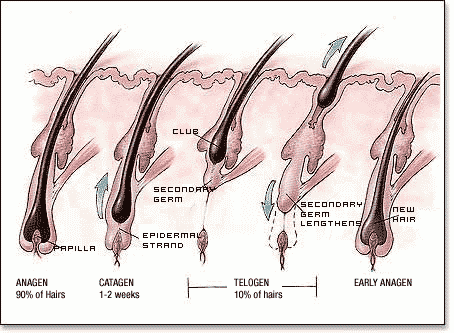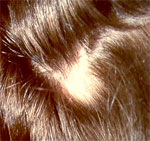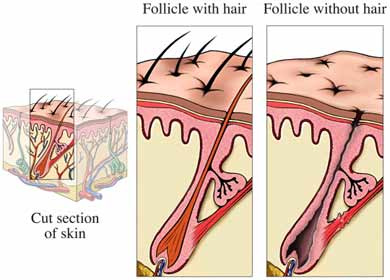
how to treat hair loss and falling of hair
A certain amount of hair loss is normal but excessive loss can be caused by eczema, alopecia, stress or a change in hormone levels. Hair Loss may be due to taking the pill or pregnancy, excess alcohol or nicotine or quite simply tying the hair back too harshly.
Stress and Hair Loss
It is believed that there is a link between stress and depression,
and hair loss. There are documented cases of people starting to lose
hair, anything from a few weeks to a few months after a stressful episode in
their lives. Of course, hair loss itself is stressful, so it is not always
clear which came first, hair loss or stress. According to the
How to treat Hair Loss
Change to a healthy diet and if the condition doesn't improve it is a good idea to consult your doctor
As you can see with the many variations of hair type and problems, your choice of style is an individual decision. The way you dress your hair is one of the simplest forms of self-expression. If you are happy with your hair, you will feel and look good.
Hair loss
Hair loss in women does not result in complete baldness as it often happens with men. But nevertheless it is a cause for acute embarrassment. Many a woman would have experienced this condition at some stage in her life. Read on to understand the regular cycle of hair growth and sudden shifts in this cycle that cause hair loss. Thinning hair and falling hair could be indicative of an underlying health condition.
Understanding the hair cycle:
Cause for Hair loss and falling hair conditions can be better understood when we are clear with the various stages of our hair cycle.

Anagen: This is the growing phase of hair and it remains at this stage for about one or two years. Nearly ninety percent of our hair is usually in this stage.
Telogen: The hair rests during this phase. Eight percent of hair remains
here for three to four months
.
Catagen: This is the stage when hair falls out and accounts for nearly
two percent of hair.
New hair then grows in its place. Hair growth is about one centimeter per
month. When hair loss is more than this cycle, it leads to a condition of
abnormal hair loss. Excessive hair loss or thinning hair can occur due to a
number of reasons.
Causes of hair loss: Fungal infections can also cause hair loss. Diseases such as diabetes or lupus can manifest in early symptoms such as severe hair loss. Systemic illnesses such as hepatic disease and Crohn's disease are known to cause severe hair fall. Individuals produce less hair as they grow older and it is more liable to dryness and breakage. Improperly done coloring, perming and straightening treatments cause hair to fall out. Tight ponytails or braids can also cause hair loss especially around the forehead. Nutritional factors such as starvation, yo-yo dieting and crash diets can result in diffused hair loss. A deficiency of Iron and Zinc can also manifest in falling hair and can be diagnosed by a simple blood test. |
Types of hair loss:
Telogen Effluvium:
Hair loss of this kind begins with overall thinning of hair from the entire scalp. A condition of this kind starts manifesting itself after an extremely stressful condition such as pregnancy, major surgery or any life-changing event. Hormonal fluctuations can also result in Telogen Effluvium. Synchronized shifts from Anagen to Talogen phases will result in this kind of sudden hair loss. Once the underlying cause is identified and suitably addressed, the hair cycles will revert to their unsynchronized patterns resulting in a normal hair growth cycle.

Androgenetic Alopecia:
Females suffering Androgenetic Alopecia rarely bald completely. Androgenetic alopecia can result from thinning of hair due to genetic factors. The hair on the crown area shows a marked thinning. Female pattern Baldness (FPB) is characterized by general thinning of hair all over the head. This typically begins around the age of 30 and becomes prominent around 40. Linked to menopause, this condition leads to a balding area around the head or sometimes a receding hairline.

Alopecia Areata
This kind of balding pattern appears as small round patches of hair loss. It is a hair loss disease that appears to be set off as an autoimmune reaction when the cells prevent hair follicles from producing hair. This condition is characterized by sudden hair loss followed by patches of baldness and finally the hair growth is restored.
Cause of hair loss in men:
DHT (Dihydrotestosterone) is a highly active form of testosterone that causes
hair follicle to degrade thereby shortening the anagen phase. 5-alpha reductase
is the enzyme that affects the conversion of testosterone to DHT. A shorter
anagen stage results in more hair fall as well as rapidly thinning hair.
However, the sebaceous glands attached to the hair follicles remain unchanged.
The glands continue to secrete oil and therefore it will be noticed that
thinning hair results in flatter and oilier hair.
